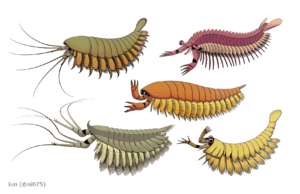Megacheira facts for kids
Quick facts for kids Megacheira |
|
|---|---|
 |
|
| Leanchoilia (top), Yohoia (left), Haikoucaris (right) and Fortiforceps (bottom). | |
| Scientific classification |
|
| Kingdom: | Animalia |
| Phylum: | Arthropoda |
| Class: | †Megacheira Hou and Bergström, 1997 |
| Groups | |
|
|
Megacheira (say "Mega-KY-ra") means "great hands." These were a group of extinct arthropods that lived long ago. Arthropods are animals with an outside skeleton, like insects, spiders, and crabs. Megacheira were special because they had a pair of large, strong claws or "hands" at the front of their bodies. They used these for hunting.
Most Megacheira lived in the ocean during the Cambrian Period, which was about 541 to 485 million years ago. They seemed to be quite common back then. However, scientists have also found fossils of some Megacheira that lived much later. For example, a fossil of Enalikter was found in England from the Silurian Period (about 443 to 419 million years ago). Another species, Bundenbachiellus, was found in Germany from the early Devonian Period (about 419 to 359 million years ago). This shows they survived for a very long time!
Contents
What Were Megacheira?
Megacheira were predatory animals, meaning they hunted other creatures for food. Their most noticeable feature was their big front appendages, which looked like strong claws or pincers. These "great hands" were perfect for grabbing prey.
Their Place in the Animal Kingdom
Scientists think Megacheira might be related to early chelicerates. Chelicerates are a group of arthropods that includes spiders, scorpions, and horseshoe crabs. Like chelicerates, Megacheira had a body divided into two main parts and lacked antennae. Their unique front claws set them apart from other arthropods of their time.
Where Did Megacheira Live?
Most Megacheira fossils have been found in ancient marine (ocean) environments around the world. They were especially common during the middle of the Cambrian Period. This was a time when many new types of animals appeared on Earth.
Ancient Oceans and Continents
During the Cambrian Period, the continents were in different places than they are today. The oceans were full of strange and wonderful creatures. Megacheira were part of these early ocean ecosystems, playing an important role as hunters. Finding their fossils in different parts of the world tells us they were widespread.
Images for kids
See also
 In Spanish: Megaqueiros para niños
In Spanish: Megaqueiros para niños



